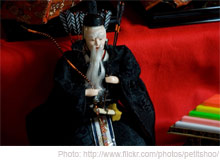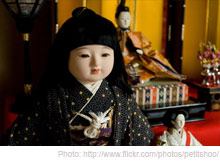Read about the festivities on March 3, during the Hinamatsuri festival – a day of traditional snacks and beautiful dolls.

After バレンタインデー (Valentine’s Day) has passed, most department stores and lots of supermarkets start displaying gorgeous dolls called ひな人形(ひなにんぎょう – hina ningyou – hina dolls). These dolls wear 平安時代(へいあんじだい – heian jidai – Heian Period) costumes, and also lots of accessories (like a paper lump and a folding fan, etc.) are displayed with the dolls on a piece of red cloth.
The 3rd of March is called ひな祭り(ひなまつり – hina matsuri – hina festival), and we regard the day as “girl’s day.” When a female baby is born, the parents may buy ひな人形 (hina dolls) for her, or they may leave it to her grandparents, because the dolls are so expensive. But if her mother already has some dolls, they may not buy new ones, or they may just add some dolls or accessories if the mother doesn’t have a complete set.
 The most important dolls are おだいりさま(お内裏様 – odairisama – Emperor) and おひなさま(お雛様 – ohinasama – Empress), so some people have just these two. Since a large space is necessary to display a complete set of ひな人形 (hina dolls), you might be happy with just those two, depending on the size of your room. Anyway, you can see complete sets at department stores, and other places. In addition to these two, there are さんにんかんじょ(三人官女 – sannin kanjo – three court ladies) and ごにんばやし(五人囃子 – gonin bayashi – five court musicians) which are three drummers, one flute player and one singer. The original models for these dolls seem to have been people in the palace of the 天皇(てんのう – tennou – Emperor), but the dolls attained their current gorgeous forms during the 明治時代(めいじじだい – meiji jidai – Meiji period), which came after the end of the Edo period.
The most important dolls are おだいりさま(お内裏様 – odairisama – Emperor) and おひなさま(お雛様 – ohinasama – Empress), so some people have just these two. Since a large space is necessary to display a complete set of ひな人形 (hina dolls), you might be happy with just those two, depending on the size of your room. Anyway, you can see complete sets at department stores, and other places. In addition to these two, there are さんにんかんじょ(三人官女 – sannin kanjo – three court ladies) and ごにんばやし(五人囃子 – gonin bayashi – five court musicians) which are three drummers, one flute player and one singer. The original models for these dolls seem to have been people in the palace of the 天皇(てんのう – tennou – Emperor), but the dolls attained their current gorgeous forms during the 明治時代(めいじじだい – meiji jidai – Meiji period), which came after the end of the Edo period.
Setting up and Taking Down the Dolls
Well, after 立春 (りっしゅん – risshun), which is the 4th of February, you can start to display ひな人形 (hina dolls) in your room. If you have a complete set of dolls, it takes a lot of time to finish setting them up. Each of the dolls is cherished, so needless to say, you must treatthem with great care. We think that a 人形(にんぎょう – ningyou – doll) guards a human by accepting bad things like 病気 (びょうき – byouki -illness) in place of the human, so buying ひな人形 (hina dolls) for a girl means wishing her good health and happiness as well. Interestingly enough, you must put the dolls back to where they are stored (often a closet) as soon as the day of ひな祭り (Hinamatsuri, 3rd of March) ends – otherwise you risk missing an opportunity to marry, lol.
Anyway, girls have a party in the room where the dolls are displayed on that day (the 3rd of March). By the way, the day is also called もものせっく (桃の節句 – momo no sekku). We have five せっく (節句 – sekku – changes of season) a year, and 桃(もも – momo) means “peach.” This is the time when the peach flowers blossom– the fruits appear later, in the summer. You might put peach blossoms on the party table, or you might buy a bunch of flowers including branches of peach blossoms even if you don’t have a party. We feel that red is a merry color here in Japan, but with food, in practice, the color is usually pink. 赤飯(せきはん – sekihan – pink rice with red beans) is one such food which is served on the celebration table. We regard pink not only as a merry color, but also as the color of spring. In fact, the Japanese word for the color pink is 桃色 (ももいろ – momoiro – literally, “peach color”).
Foods and Sweets
So you will probably see some pink food on the table. さくらもち (sakuramochi), one of the most popular Japanese sweets, is made from rice powder, sweet bean paste and salted cherry leaves, which smell like cinnamon. You can buy these お菓子 (おかし – okashi – sweets) any time of the year, but especially around this season, and especially on the day ひな祭り (Hinamatsuri), you will probably start wanting to eat these pale pink sweets. If you invite some friends to your party, some of them may bring さくらもち (sakuramochi) to you as a little gift.
Whether or not they’re pink, lots of sweets companies prepare peach products like peach ice cream, small cakes with peach flavor cream, peach pudding, and so on. Some cake shops might have peach flavored treats, but most cake shops have special decorated cakes called ひなデコ (hina deko), rather than peach cakes. There are bigger round cakes called デコレーションケーキ(dekoreeshon keeki – decorated cakes) around here, and we often eat them when we celebrate something like a birthday. The word “デコ” is the short form of “デコレーション” (decoration), and “ひな (hina)” refers to ひな人形 (hina dolls) or ひな祭り (Hinamatsuri). Each cake shop has its own ひなデコ or ひなデコ・ケーキ; for example, a small お内裏様 (Emperor) and お雛様 (Empress) on top of a sponge cake covered with fresh whipped cream. Such dolls might be plastic, or made of 砂糖(さとう – satou – sugar). Well, lots of cake shops sell ひなデコ as the special cakes for the day, and you might find recipes of ひなデコ on some websites. But you find there are other names like おひな様ケーキ (ohinasama keeki) and ひな祭りケーキ (hinamatsuri keeki) instead of the word ひなデコ at cake shops and websites.
Speaking of sweets for ひな祭り (Hinamatsuri), that reminds me of 菱餅, ひしもち (hishimochi). 菱 (hishi) is an abbreviation for 菱形, ひしがた (hishigata – diamond-shaped), and it’s made with three colors of 餅(もち – mochi – sticky rice cakes); 緑 (midori – green), 白 (shiro – white) and ピンク (pinku – pink). It’s said that each of the colors stands for something– pink for flowers or the season of spring, white for snow or the season of winter, and green for leaves or the earth. Originally 菱餅 (diamond-shaped mochi) were 餅 (mochi – sticky rice cakes), but recently there are more products like hishi jelly, ice cream with the three hishimochi colors, and so on.
Floating Down a River
Well, as I mentioned above, you should put your dolls back where they are stored until the following year, but in some regions, the custom is to float them down a river. That came from the idea that dolls accept your illness and other bad luck, and that these bad things should be removed from you. It’s called 流し雛, ながしびな(nagashi bina). Actually, this is the original form of ひな祭り (Hinamatsuri) in the Emperor’s palace, and some 流し雛 (floating -downriver- hina dolls) have a long history. The custom depends on the region, but in most regions, ひな人形 (hina dolls) are made from paper. In these regions, such paper dolls are put in a ship (made from leaves or straw or such), and people float them down rivers while wishing for good luck (mainly for women). The ship, its contents, and the date of the ceremony depend on the area, it seems.
Most kindergartens celebrate ひな祭り (Hinamatsuri) on that day (the 3rd of March) unless it’s Sunday. Children make ひな人形 (hina dolls) as 折り紙, おりがみ (origami – paper folding), which is one of the traditional Japanese paper arts. Or children might dress up as お雛様 (hina dolls/Empress), wearing cute (although simple) costumes. So you can
enjoy ひな祭り even if you don’t have real ひな人形 in your house. Personally, I was more interested in playing with plastic monsters than in dressing up as a pretty Empress (lol), but I used to do 折り紙 (origami) and at times I made more delicate paper dolls with 和紙, わし(washi – Japanese traditional paper).
Notes on the Article
There are some kanji which are rather difficult and tiresome, and some people prefer using hiragana in place of the original kanji. In this article, 雛 and 菱 are examples of that. Some people write ひな人形 instead of 雛人形, and both ways of writing the word are common. Similarly, ひし形 and ひし餅 are commonly used.
You might have noticed that I used the word お雛様 (you can also write おひな様) to mean both “Empress” and “hina dolls.” When you talk about specific dolls, you distinguish between お内裏様 (the Emperor) and お雛様 (the Empress). Apart from that, we often call the dolls お雛様 instead of saying 雛人形. Using the word 雛人形 makes the dolls sound like just objects, so お雛様 is a friendlier word for the dolls. I think that people use お雛様 to refer to hina dolls in general because the Empress was the most important of the hina dolls.
By the way, the words お内裏様 (Emperor) and お雛様 (Empress) are used only as names for those dolls. In real life, one says 天皇陛下 (てんのうへいか – tennou heika) for an emperor, and 皇后陛下 (こうごうへいか – kougou heika) for an empress. The word 陛下(heika) is a title, like さん, but it is used only for these two people. If you read a Japanese translation of a western book from the Medieval period, you will find that a queen is called 女王陛下(じょおうへいか – joou heika).
There are lots of color names which come from flowers, but actually they don’t refer to the exact color of the flower. For example, we commonly use the word ピンク (pinku – pink). 桃色 (momoiro – peach color) also means pink, but we don’t use it ordinarily when talking about the color. It’s often used in poems, however, and it can give different feelings to the reader depending on the situation– sweet, soft, or at times erotic.
